
The milkfish is the sole living species in the family Chanidae. However, there are at least five extinct genera from the Cretaceous. The repeating scientific name (tautonym) is from Greek khanos.
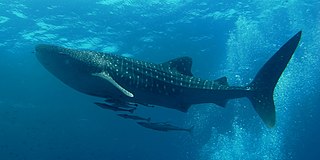
The whale shark is a slow-moving, filter-feeding carpet shark and the largest known extant fish species. The largest confirmed individual had a length of 18.8 m (61.7 ft). The whale shark holds many records for size in the animal kingdom, most notably being by far the largest living nonmammalian vertebrate. It is the sole member of the genus Rhincodon and the only extant member of the family Rhincodontidae, which belongs to the subclass Elasmobranchii in the class Chondrichthyes. Before 1984 it was classified as Rhiniodon into Rhinodontidae.

The megamouth shark is a species of deepwater shark. It is rarely seen by humans and is the smallest of the three extant filter-feeding sharks alongside the whale shark and basking shark. Since its discovery in 1976, fewer than 100 specimens have been observed or caught. Like the other two planktivorous sharks, it swims with its mouth wide open, filtering water for plankton and jellyfish. It is recognizable from its large head with rubbery lips. The megamouth is so unlike any other type of shark that it is usually considered to be the sole extant species in the family Megachasmidae, though some scientists have suggested it may belong in the family Cetorhinidae, of which the basking shark is currently the sole extant member.

The cobia is a species of carangiform marine fish, the only representative of the genus Rachycentron and the family Rachycentridae. Other common names include black kingfish, black salmon, ling, lemonfish, crabeater, prodigal son, codfish and black bonito.
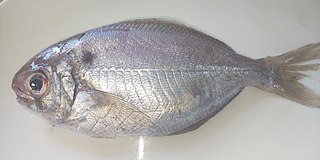
The Pacific rudderfish is a marine fish also known by such names as Japanese butterfish, melon seed, wart perch, ibodai or simply but ambiguously as butterfish.
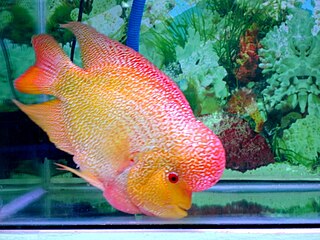
Flowerhorn cichlids are ornamental aquarium fish noted for their vivid colors and the distinctively shaped heads for which they are named. Their head protuberance, or kok, is formally termed a nuchal hump. Like blood parrot cichlids, they are man-made hybrids that exist in the wild only because of their release. Flowerhorns first emerged for sale on the aquarium market in Malaysia in the late 1990s and soon became popular in many countries in Asia. First developed in Malaysia, Thailand, and Taiwan, they became very popular with Asian fish hobbyists. They are also kept by hobbyists in the US, India and Europe. Numerous cast-off flowerhorns have been released to the wild, especially in Singapore and Malaysia, where they have become an invasive pest animal. Their importation is banned in Australia.

The prickly shark is one of the two species of sharks in the family Echinorhinidae, found in the Pacific Ocean over continental and insular shelves and slopes, and in submarine canyons. Bottom-dwelling in nature, it generally inhabits cool waters 100–650 m (330–2,130 ft) deep, but it also frequently enters shallower water in areas such as Monterey Bay off California. This stocky, dark-colored shark grows up to 4.0 m (13.1 ft) long, with two small dorsal fins positioned far back on its body and no anal fin. It is characterized by a dense covering of thorn-like dermal denticles, hence its common name.

The Japanese bullhead shark is a species of bullhead shark in the family Heterodontidae found in the northwestern Pacific Ocean off the coasts of Japan, Korea, and China. This benthic shark occurs at depths of 6–37 m (20–121 ft) over rocky bottoms or kelp beds. Measuring up to 1.2 m (3.9 ft) long, it can be identified by its short, blunt head, two high dorsal fins with anterior spines, and pattern of irregularly shaped, vertical brown bands and stripes. The Japanese bullhead shark is a docile, slow-swimming species that feeds mainly on shelled invertebrates and small bony fishes. Reproduction is oviparous, with females laying spiral-flanged eggs in communal "nests". This species is of little interest to fisheries.
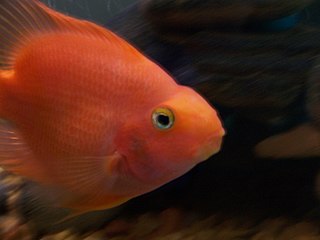
The blood parrot cichlid is a hybrid thought to be between the midas and the Gold Severum cichlid, although the true parent species has not been confirmed by breeders. The fish was first bred in Taiwan around 1986. Blood parrots should not be confused with other parrot cichlids or salt water parrotfish. Natural colors of the fish are red, yellow, and grey: other colors are injected by breeders.

The gecko catshark is a species of catshark, part of the family Scyliorhinidae, native to the northwestern Pacific Ocean from southern Japan to Taiwan, and possibly also off Vietnam. It is a common, demersal species found at depths of 100–900 m (330–2,950 ft). Its body is slender, with a pattern of dark saddles and blotches. The dorsal and caudal fins are edged in white, and there is a prominent crest of enlarged dermal denticles along the dorsal edge of the caudal fin. The gecko catshark is a schooling, opportunistic predator of bony fishes, cephalopods, and crustaceans. It is oviparous, with females producing two vase-shaped egg capsules at a time. This species is captured as bycatch, but does not appear to be threatened by fishery activities at present and has been assessed as Least Concern by the International Union for Conservation of Nature (IUCN).

The blacktip sawtail catshark is a species of catshark, and part of the family Scyliorhinidae, found off the coasts of Taiwan and the Philippines. It is demersal in nature and occurs deeper than 60 m (200 ft). Growing up to 46 cm (18 in) long, this slim-bodied species is characterized by its plain brownish dorsal coloration with dark tips on the dorsal and caudal fins, and a prominent crest of enlarged dermal denticles on the upper edge of the caudal fin. It is oviparous, with females producing encapsulated eggs two at a time year-round. The blacktip sawtail catshark is caught incidentally in bottom trawls and used for fishmeal in Taiwan.

The Taiwan angelshark is an angelshark in the family Squatinidae. The Taiwan angelshark is one of four species of Squatina in the waters around Taiwan and Japan. It is a demersal, ray-like shark that grows to 1–2 meters in length.

Bathygadus antrodes is a gadiform fish, a species of rattail. It is found at depths of up to 1200 m in the waters around southern Japan and northern Taiwan.
Bathygadus garretti is a species of rattail. This is a deep-water fish found in the waters around southern Japan and northern Taiwan.

Gadomus colletti is a species of rattail. This deep-water fish is found in the waters around Japan, the Philippines, and northern Taiwan.
Coelorinchus longissimus is a species of rattail; this deep-water fish is found in the waters around Taiwan and southern Japan.
The unicorn grenadier, Coelorinchus productus, is a species of rattail. This fish is found at depths of up to 600 metres (2,000 ft) in the waters around northern Taiwan, southern Japan and the East China Sea.
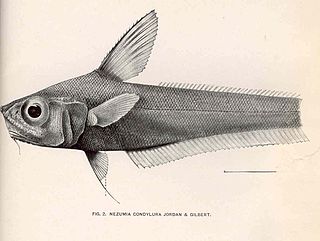
The Japanese pugnose grenadier is a species of rattail fish. It is found at depths of up to 720 m in the waters around southern Japan, northern Taiwan and in the East China Sea.

The bluespotted trevally, also known as the wide-mouthed trevally, is a species of moderately large marine fish in the jack family Carangidae. The bluespotted trevally is distributed through the tropical east Indian and west Pacific Oceans, ranging from Taiwan in the north to Australia in the south. It is an inshore species, found in sandy, muddy and seagrass environments, often in large bays. The bluespotted trevally is distinguished by dark blue spots on its upper body, as well as a number of more detailed anatomical features. It is a benthopelagic predator, taking a variety of crustaceans including crabs and prawns as a juvenile, before shifting to a more fish-dominated diet as an adult. It is one of the most common predators in the Gulf of Carpentaria of northern Australia, and is considered the most important predator of commercially important prawn species. Sexual maturity is reached at 110 mm in length and one year of age, with spawning occurring year round with a peak in spring. Growth is estimated to be 82.2 mm per year for both sexes, reaching a maximum known length of 66 cm. Bluespotted trevally are commonly taken as bycatch in prawn fisheries, however are of little commercial value and often discarded. They are occasionally taken by anglers on lures and baits, but are considered mediocre table fare.

The Indonesian angelshark is a rare species of angelshark, family Squatinidae, known only from a few specimens collected from fish landing sites in southern Indonesia. It is thought to inhabit the deep waters of the continental slope. Reaching at least 1.34 m (4.4 ft) long, this species has a flattened, ray-like shape and a well-developed tail and caudal fin. It is characterized by the absences of fringes on its nasal barbels and thorns down the midline of its back, as well as by its relatively plain grayish-brown dorsal coloration with dark saddles beneath the dorsal fin bases and a black leading margin on the underside of the pectoral fins. The International Union for Conservation of Nature (IUCN) has classified it as Critically Endangered due to significant fishing pressure.
















